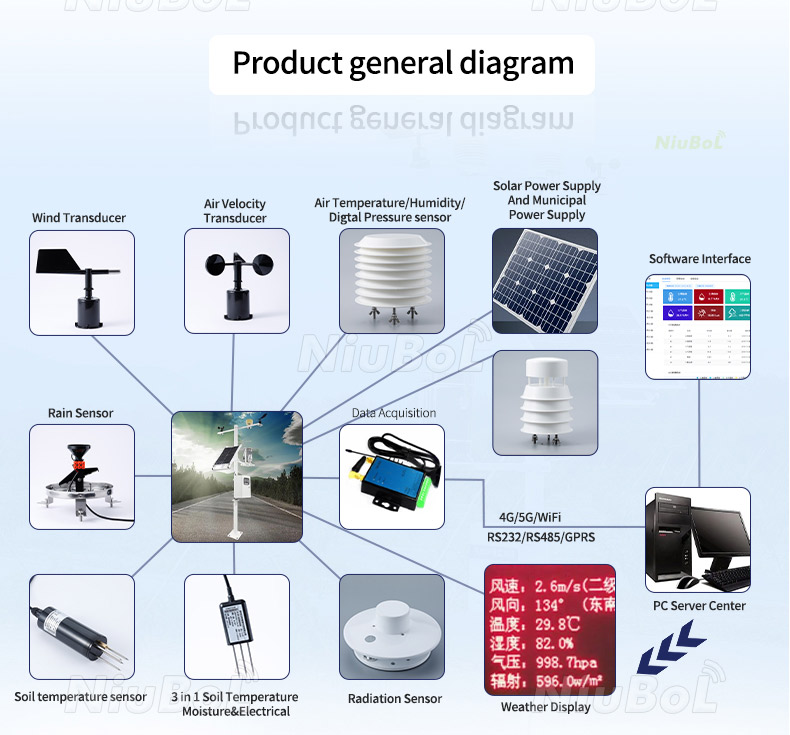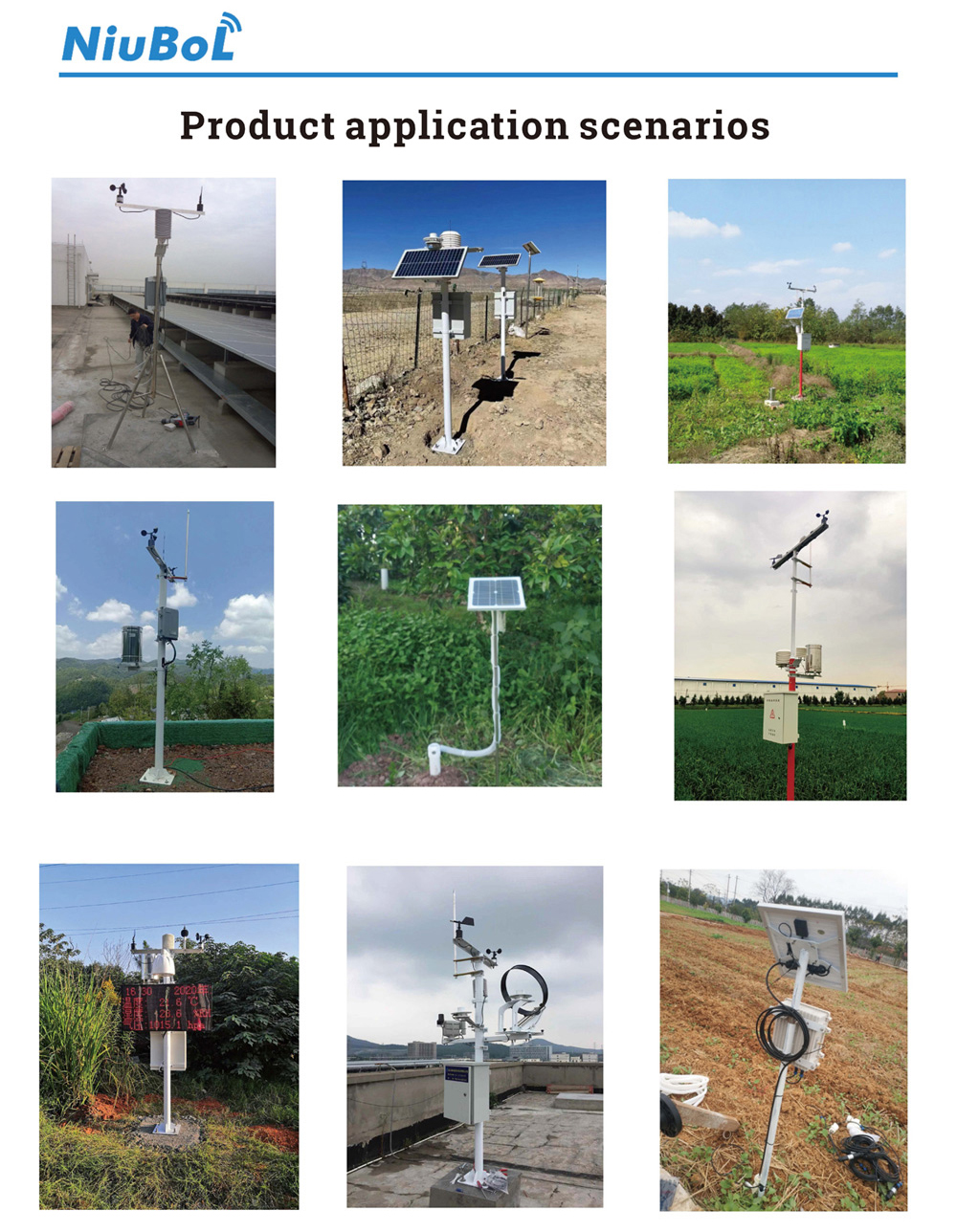

— Blogs —
—Products—
 Consumer hotline +8618073152920
Consumer hotline +8618073152920 WhatsApp:+8615367865107
Address:Room 102, District D, Houhu Industrial Park, Yuelu District, Changsha City, Hunan Province, China
Product knowledge
Time:2024-09-01 15:08:45 Popularity:1163
Weather Station is a system for real-time monitoring of meteorological data and environmental data. It is capable of collecting information on a variety of meteorological elements, including ambient temperature, humidity, dew point temperature, wind direction, wind speed, precipitation, barometric pressure, solar radiation, etc., which provides important data support for meteorological forecasting, agricultural production, environmental protection, transport and other fields. According to the usage, installation and accuracy, the weather station can be divided into various types such as portable weather station, high-precision weather station, highway weather station, forest fire risk weather station, campus weather station, electric power weather station, photovoltaic weather station, scenic weather station, community weather station, and so on.
MQTT weather station refers to the weather station that adopts MQTT (Message Queuing Telemetry Transport) protocol for data transmission.MQTT is a lightweight open communication protocol widely used in the field of Internet of Things (IoT). Through the MQTT protocol, the weather station can publish the collected weather data to the MQTT proxy server in real time, and the related systems or platforms can subscribe to these data to achieve real-time data acquisition and processing.MQTT weather station has the advantages of high data transmission efficiency, low power consumption, high reliability, and is especially suitable for the scenarios that require remote monitoring and data transmission.

MQTT weather station compared with the traditional weather station has a variety of advantages, mainly reflected in the following aspects:
1. Real-time data transmission: MQTT protocol supports real-time publish and subscribe messages, which enables the weather station to instantly send the collected weather data to the MQTT proxy server, and the relevant systems or platforms can immediately access the latest data, thus real-time updating and monitoring of weather data.
2. Efficient Data Processing: The design of MQTT protocol takes into account low overhead and low bandwidth consumption, which makes meteorological data more efficient in the transmission process. At the same time, MQTT protocol supports multiple Quality of Service (QoS) levels, so you can choose the appropriate QoS level according to the actual needs to ensure the reliable transmission of data.
3. Wide applicability: MQTT weather station is not restricted by geographical location and network conditions, as long as the device can be connected to the Internet, it can transmit data through the MQTT protocol. This makes MQTT weather station can be widely used in various environmental conditions, including remote areas, mountainous regions, islands and so on.
4. Easy to expand and maintain: the MQTT protocol is open and extensible and can be easily integrated with other IoT devices and systems. In addition, MQTT weather stations usually have a modular design, which can be configured and expanded according to actual needs, while supporting remote monitoring and management, reducing the cost of maintenance and upgrading.
5. Low Power Consumption: The low overhead characteristics of the MQTT protocol enable weather stations to save energy during data transmission and extend the service life of the equipment. This is especially important for automatic weather stations that need to run for a long time.

Due to its unique advantages, MQTT weather station is suitable for application in a variety of environments, including but not limited to the following:
1. Agricultural production: agricultural production is very sensitive to meteorological conditions, MQTT weather station can monitor the meteorological data of farmland in real time and provide farmers with precise planting suggestions and management decisions, so as to improve the yield and quality of crops.
2. Environmental monitoring: in the field of environmental monitoring, MQTT weather station can monitor real-time air quality, water quality and other environmental parameters, providing data support for environmental protection departments. Especially in remote areas or areas that are difficult to monitor directly, MQTT weather stations can play an important role.
3. Smart city: in the construction of smart city, MQTT weather station can be used as an important part of the city weather monitoring network, providing real-time and accurate weather data for city managers to support urban planning, traffic management, disaster warning and other work.
4. Industrial field: in the process of industrial production, meteorological conditions have an important impact on production safety and efficiency, MQTT weather station can monitor the meteorological data of industrial sites in real time to provide data support for production scheduling and safety management.
5. Scientific research and education: In the field of scientific research and education, MQTT weather station can be used in meteorological observation experiments and teaching activities, helping students and researchers to understand the process of meteorological data collection and processing, and deepen their understanding and knowledge of meteorological science.

In summary, due to its advantages of real-time, high efficiency and wide applicability, MQTT weather station is suitable to be applied in a variety of environments such as agricultural production, environmental monitoring, smart city, industrial field and scientific research and education.
Related recommendations
Sensors & Weather Stations Catalog
Agriculture Sensors and Weather Stations Catalog-NiuBoL.pdf
Weather Stations Catalog-NiuBoL.pdf
Related products
 Combined air temperature and relative humidity sensor
Combined air temperature and relative humidity sensor Soil Moisture Temperature sensor for irrigation
Soil Moisture Temperature sensor for irrigation Soil pH sensor RS485 soil Testing instrument soil ph meter for agriculture
Soil pH sensor RS485 soil Testing instrument soil ph meter for agriculture Wind Speed sensor Output Modbus/RS485/Analog/0-5V/4-20mA
Wind Speed sensor Output Modbus/RS485/Analog/0-5V/4-20mA Tipping bucket rain gauge for weather monitoring auto rainfall sensor RS485/Outdoor/stainless steel
Tipping bucket rain gauge for weather monitoring auto rainfall sensor RS485/Outdoor/stainless steel Pyranometer Solar Radiation Sensor 4-20mA/RS485
Pyranometer Solar Radiation Sensor 4-20mA/RS485
Screenshot, WhatsApp to identify the QR code
WhatsApp number:+8615367865107
(Click on WhatsApp to copy and add friends)
